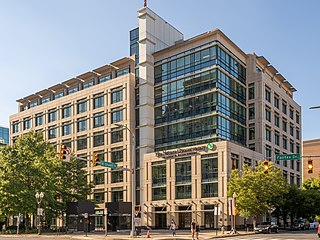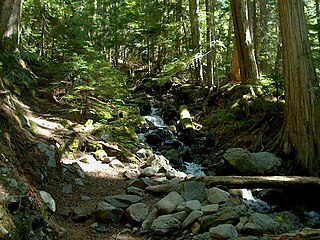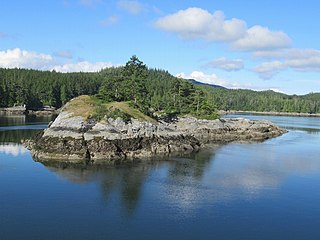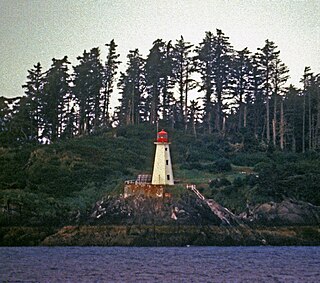
The Nature Conservancy (TNC) is a global environmental organization headquartered in Arlington, Virginia. As of 2021, it works via affiliates or branches in 79 countries and territories, as well as across every state in the US.

The Kermode bear, sometimes called the spirit bear, is a subspecies of the American black bear and lives in the Central and North Coast regions of British Columbia, Canada. It is the official provincial mammal of British Columbia and symbol of Terrace, British Columbia. While most Kermode bears are black, between 100 and 500 fully white individuals exist. The white variant is known as spirit bear, and is most common on three islands in British Columbia, where they make up 10–20% of the Kermode population. Spirit bears hold a prominent place in the oral traditions of the indigenous peoples of the area. They have also been featured in a National Geographic documentary and in the BBC TV series Planet Earth III
The protected areas of Michigan come in an array of different types and levels of protection. Michigan has five units of the National Park Service system. There are 14 federal wilderness areas; the majority of these are also tribal-designated wildernesses. It has one of the largest state forest systems as well having four national forests. The state maintains a large state park system and there are also regional parks, and county, township and city parks. Still other parks on land and in the Great Lakes are maintained by other governmental bodies. Private protected areas also exist in the state, mainly lands owned by land conservancies.

Klemtu is an unincorporated community on Swindle Island in the coastal fjords of British Columbia, Canada. It is located on Kitasoo Indian Reserve No. 1.

The Great Bear Rainforest is a temperate rain forest on the Pacific coast of British Columbia, comprising 6.4 million hectares. It is part of the larger Pacific temperate rainforest ecoregion, which is the largest coastal temperate rainforest in the world.
Khutzeeymateen Provincial Park, also known as Khutzeymateen/K'tzim-A-Deen Grizzly Sanctuary, is a Class A provincial park located in the North Coast region of British Columbia, Canada. The park, within the purview of BC Parks, was established on August 15, 1994, to protect critical habitat for the region's grizzly bear population and the largest contiguous stand of old-growth Sitka spruce in the world. It was officially opened by Prince Philip, Duke of Edinburgh, on August 17, 1994.

The Purcell Wilderness Conservancy is a provincial park in British Columbia, Canada. It was established in 1974, and encompasses six large drainages in the Purcell Mountains in the southeast of the province. It contains high peaks, alpine meadows and ridges, deep creek and river valleys, and hot springs at Dewar Creek.

British Columbia mainland coastal forests is a temperate coniferous forest ecoregion the Pacific coast of North America, as defined by the World Wildlife Fund (WWF) categorization system.

təmtəmíxʷtən/Belcarra Regional Park is a 1,100-hectare (2,700-acre) regional park located in Belcarra, Greater Vancouver, British Columbia. It is northeast of the meeting of Burrard Inlet with Indian Arm, beginning near Belcarra Bay and extending to Sasamat Lake. The park is northwest of the Village of Anmore and to the southwest of Buntzen Lake. Apart of its 1,104 hectares, are the 92 hectares of Admiralty Point Lands, ocean waterfront lands in Port Moody.

Broughton Archipelago is a group of islands located at the eastern end of Queen Charlotte Strait in Mount Waddington Regional District, British Columbia. The archipelago is the traditional territory of the Musgamagw Dzawada'enuxw, Namgis, Ma'amtagila and Tlowitsis nations of the Kwakwaka'wakw peoples.
The Estevan Group, formerly the Estevan Islands, is a small archipelago in the Hecate Strait region of the North Coast of British Columbia, Canada. It is to the west of Campania Island, which is separated from the group by Estevan Sound, and is itself to the west of Gil Island across Squally Channel. Southeast of it and of the Estevan Group is Caamaño Sound, beyond which is Aristazabal Island; to the east of all is Princess Royal Island, the fourth largest on the British Columbia Coast. To the northwest of the group is Banks Island.

Campania Island is an island on the coast of the Canadian province of British Columbia. It is located south of Prince Rupert, east across Hecate Strait from Haida Gwaii. To its west, across Estevan Sound, is the Estevan Group archipelago. Banks Island lies to the northwest, across Nepean Sound; and Pitt Island to the north, across Otter Channel. To the northeast, across Squally Channel, is Gil Island, and to the east is Princess Royal Island, across Campania Sound. To the south of Campania Island is Caamaño Sound, beyond which is Aristazabal Island.
Jody Rae Thompson is a Canadian actress, screenwriter and filmmaker working in film and television.

The Nature Conservancy of Canada (NCC) is a private, non-profit, charitable nature conservation and restoration organization based in Canada. Since its founding in 1962, the organization and its partners have protected 15,000,000 hectares of land and water across Canada, which includes the natural habitat of more than a quarter of the country’s endangered species. With offices in each province, NCC works at a local level with stakeholders and partners to secure parcels of land.
Bishop Bay – Monkey Beach Conservancy is a conservancy in British Columbia, Canada. It is 3,374 hectares in size and is accessible only by floatplane or boat. It features boat anchorage and tent platforms as well as a hotspring fed bath house. The temperature of the hotsprings is approximately 41.3 degrees Celsius at the source and about 38.8 degrees Celsius in the bath house. It is located 25 km east of Hartley Bay and 75 km south of Kitimat. The conservancy was established in 2006, with Monkey Beach being added to the conservancy in 2007.

The Kitlope Heritage Conservancy or Huchsduwachsdu Nuyem Jees in the Haisla language, is a conservancy located on the Pacific coast of the province of British Columbia, Canada. It preserves the largest continuous tract of coastal temperate rainforest in the world. Beginning at the head of Gardner Canal, the park stretches inland along the Kitlope River to the border of Tweedsmuir Provincial Park.

The Lucy Islands are a small archipelago off the North Coast of the province of British Columbia in Canada. The low-lying and heavily forested group, named after its largest island, Lucy Island, constitutes a provincially protected conservancy area that contains some of the North Coast’s oldest archeological sites, a nationally significant seabird population, and a prominent 20th-century lighthouse.
Neʼāhʼ Conservancy is a conservancy located in the Stikine Region of British Columbia, Canada. The conservancy was established on 31 March 2013 through a cooperative resource management and land use planning agreement between BC Parks and the Kaska Dena First Nations.
Duu Guusd Heritage Site/Conservancy is a heritage site and conservancy located in the northwest corner of Graham Island in the Haida Gwaii archipelago of British Columbia, Canada. It was established on March 23, 2008 to protect the ecological integrity and cultural importance of the region. The conservancy is part of an archipelago-wide system of protected areas that includes Gwaii Haanas National Park Reserve and Haida Heritage Site, Gwaii Haanas National Marine Conservation Area Reserve and Haida Heritage Site, and 17 other provincially protected areas.













